How to choose a bike seat bag

Seat bags are part of basic bikepacking equipment on longer journeys. But they aren’t necessary. Like everything they have advantages and disadvantages and it’s up to you how you will spread out your gear across the bags. Unlike the classic panniers, they don’t use the metal rack, so they don’t tend to be damaged in hard terrain.
Every cyclist knows the classic rear bags, which fits right under your saddle. You can carry tools inside, a repair kit and if you are lucky and have a proper size, you can even fit a spare tube there. Bikepacking seat bags can carry much more gear and they are usually waterproof.
You can see panniers on really long journeys, usually on roads, and expeditions. They have their advantages. They’re huge, you can put a lot of stuff there and you’re not limited by tyre clearance. But metal racks can be destroyed in rough mountain bike terrain. And those big bombs on the sides don’t have the best aerodynamic qualities. That’s why you usually see seat bags in multiday races and in hard terrain.
Seat bags are attached to the bike on two spots. On saddle rails and on a seatpost. They’re attached to the seatpost by one or two velcro straps, based on their size. But it’s not a rule. Small ones that have only a few litres of volume are attached only to the saddle itself.
On saddle rails, there are two velcro straps that are preventing swinging from side to side.
The swinging can be one of the potential disadvantages of this type of bag. Why potential? Because it doesn’t have to be a problem with bag design or construction. You can’t change the laws of physics, but they can help you if you pack your seat bag properly. Put the heaviest items closer to the seatpost so it’s closer to the centre of gravity. Remember that the bigger volume your bag has, the more stuff you will have inside and the worse the swinging will be. Be smart, minimalist, pack light.
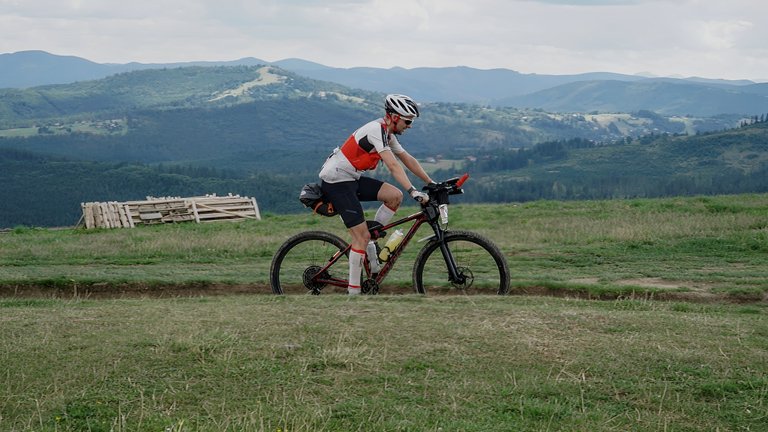
You can say, in general, that bikepacking seat bags are best for lighter things with a dynamic shape. What does dynamic shape mean? That you can scrunch it. A sleeping bag and clothes are the best. If you get a bag with a valve you will be able to compress the contents nicely.
Advantages and disadvantages of a seat bag
Usage of a seat bag and its parameters is individual. Someone can like it, another one can dislike it and it depends what are your expectations.
Advantages
- It can carry relatively bulky items
- It can be used as a fender
- It won’t break in hard terrain
Disadvantages
- It can swing around if you don’t pack it properly or it’s just too big
- Capacity is limited by tyre clearance—space between wheel and saddle
- You can’t move your centre of gravity behind the saddle
What are the parameters to watch when you’re picking a saddle bag?
Tyre clearance
The limiting factor in picking the seat bag is tyre clearance—space between the tyre and your saddle. After the boom of 29er, this space is getting smaller and smaller. You will have the biggest problem with a full suspension bike with a telescopic seatpost.
The bigger the frame, the better for you. It’s good to measure your space and add a little extra to avoid mistakes. A good manufacturer will have clearance in their manual. Otherwise, you will just have to order a bag and try it by yourself.
Space should be wide enough to avoid tyre striking. Otherwise, you could end up in an awful crash with a destroyed bag.
Be careful when you pack stuff into your seat bag. If you put heavy items at the edge, the bag won’t hold its shape and it could create a “fallen tail” which will strike the tyre. So be careful, pack smart.
It’s very hard to create more space between the saddle and tyre. You would have to change a frame or the size of the wheel. So it’s better to pick from bags that can fit it now.
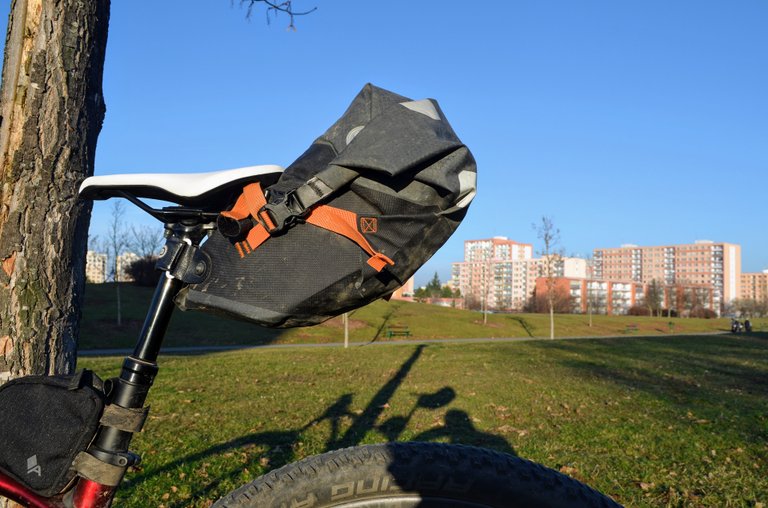
Telescopic seatpost
If you have a telescopic seatpost, it doesn’t mean you cannot have a seat bag. It’s true you will have much less variety of choices, because of space, but I found a great one for myself, so you can too.
There are bags that are made purposely for telescopic seatposts and hang only on saddle rails. Their volume is very limited but it’s better than nothing…
I found an interesting solution by Wolf Tooth Components. It’s called Valais and it’s an adapter for a telescopic seatpost. If the saddlebag only has one velcro strap, it can be attached to Valais. It will limit travel a little bit, but that’s only a low price. I tried this solution on several thousand race kilometres and it works perfectly.
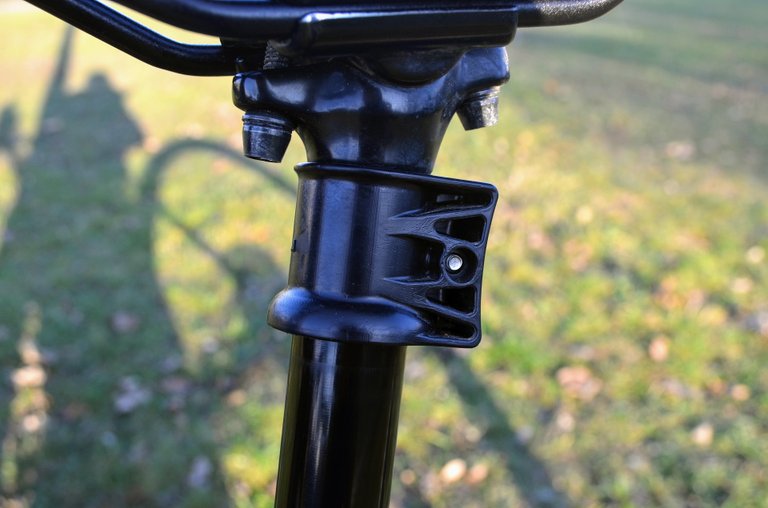
Theoretically, you can use two adapters for a bulky seat bag with two velcro straps. But it would limit travel so much you wouldn’t get any advantages from a telescopic seatpost anyway.
You would need to use a smaller bag anyway so there is enough tyre clearance. Really make sure there won’t be any contact even in the lowest position.
I like this combination because it eliminates one disadvantage of a seat bag—not being able to move your centre of gravity behind the saddle.
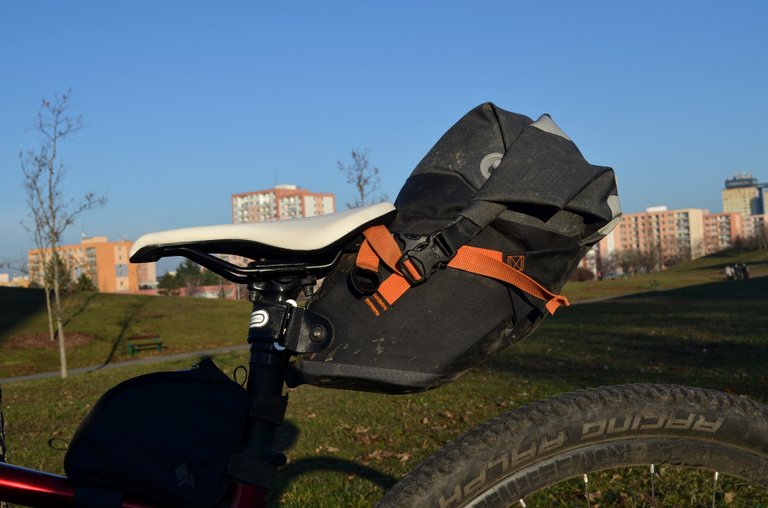
Volume
When picking the right volume for your bag, you really need to start thinking. It’s not an easy task. Volume can vary from 3 litres to 17 litres, more or less.
What do you want to put into you seat bag? I usually carry my sleeping gear (sleeping bag, bivy bag) and all my clothes in there. It’s also good to have a little extra space, in case you ever need it. To fill it into its full capacity is hard work.
The best would be to take everything you need to carry and try to fit it in. You will need a smaller bag in summer and a larger one in winter or spring.
The more volume your bag will have, the more the disadvantages of this type of bag will show—the swing, higher weight and not enough tyre clearance. You will have to make some compromises.
Weight
Ideally the lighter the better, but it’s usually not that easy. Some bags, especially the ones with higher volume, can have a heavier construction with a metal extension which allows the bag to keep its shape and reduce swinging. But with the cost of added weight.
Lighter materials are more expensive. But I wouldn’t think that lighter means a shorter lifetime.
Waterproof/Water-resistant
Attention. There is a difference between these two. Water-resistant can only withstand light rain, but your gear will get soaked in a thunderstorm. It’s doesn’t have to be a reason to reject the bag. You can use a plastic bag inside or, even better, a dry sack.
If the bag is waterproof itself, it’s more comfortable, but also more expensive.
Valve
A valve is a very useful thing, almost necessary for me. It will allow you to pack your bag much easier because you will be able to compress its content. It will hold better and won’t swing. I know of two different solutions.
- Screw valve – It’s very simple. You will unscrew the valve and air will come out. The only disadvantage is, you have to remember to screw it back when you’re done. And forgetting to isn’t a rare situation for me. I forget to zip my bags pretty often.
- Pull-out valve – You will pull the valve and it will pop out. It’s simple. I don’t have 100% trust in this system because when the valve is twisted, it will allow air to come out too. So when you pack the bag, you need to make sure that the valve is not twisted.
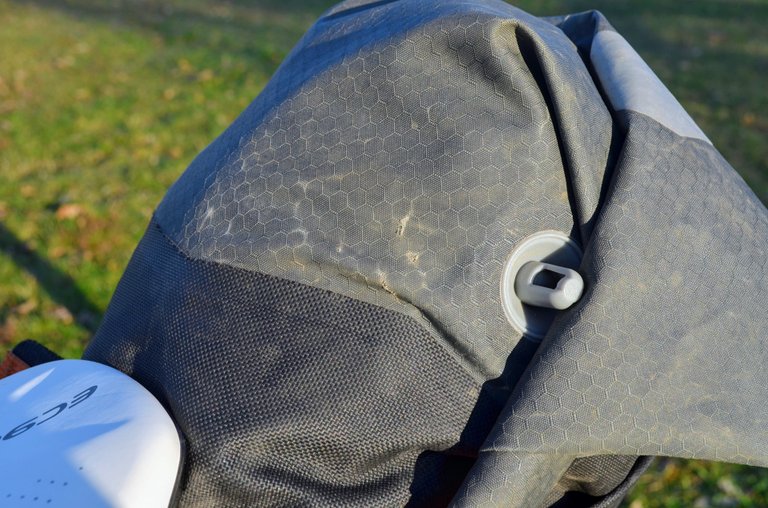
Two-piece construction
Some seat bags are constructed from two detachable pieces. The bag itself, which is mounted on the bike and the sack, where you put your gear. When you need to, you can detach the sack and take it with you—that can be very useful when commuting.
You can do the same by using your own dry sack, but it will add weight and it will be harder to pack. But when the sack is made especially for the bag, it has the right shape and it can be packed much easier.
What else to look for
There’re some more features that you should look for:
- Option to mount a rear light to bag
- Straps on the bag to hold additional gear. Just be careful to tighten it properly. I lost my gloves like that.
Summary
There are almost endless options of bags to choose from. You can pick famous brands (Revelate Design, Apidura, Ortlieb), local sellers in your country, Aliexpress (Rhinowalk) or making your own. The quality of this bag is more important than that of other ones. It’s big, farther from the centre of gravity, so there’s stronger forces affecting it than in the middle of the frame triangle.
But let’s take a look at Milan Hanyk. He gave up on all seat bag companies, put his gear into a plastic bag and won a race. Easy and cheap.
To display Facebook post allow marketing cookies.
You can find the complete list of cookies on privacy policy page.
Published | #Bikepacking
💬 No comments yet
What are your thoughts? 🤔 Feel free to ask any questions 📫